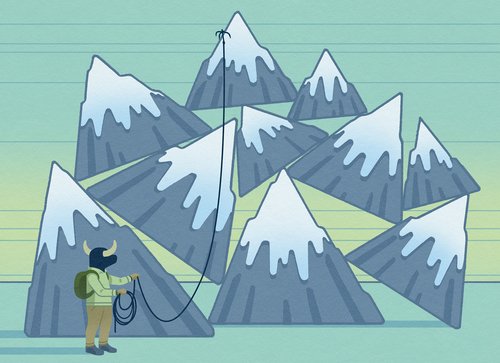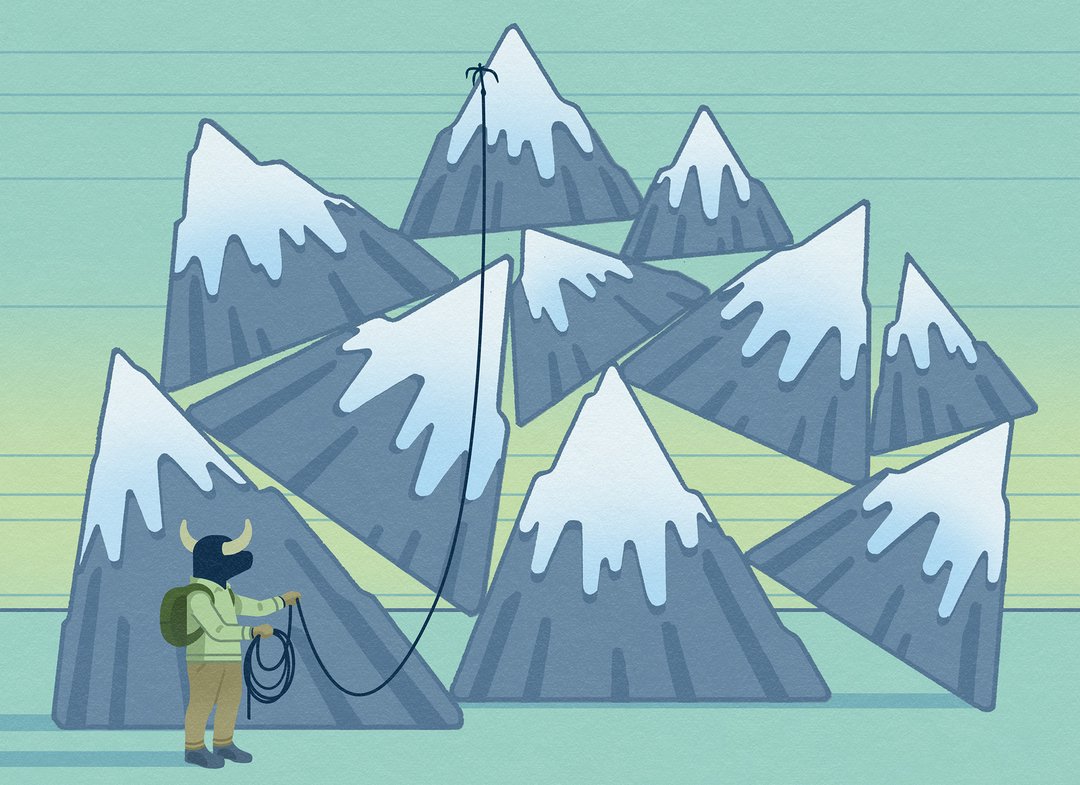
If you’ve been in the stock market for a while, congratulations. Now that the market has reached a new peak, you’ve probably made some money.
And if the news of a new market peak is enticing you to dip a toe back into the stock market — or perhaps drawing you in for the first time — this is a good moment to reflect on whether you have the emotional and financial resources to get in and stick with it for the long run.

Dan Page
The S&P 500 last Friday surpassed the peak it reached Jan. 3, 2022. After a miserable performance in 2022, the stock market had a fabulous run. Bond prices rose, too. These increases lifted investment portfolios around the world. Celebrate, by all means.
But then get past it. If you are a long-term investor, this particular market peak isn’t likely to matter.
Staying in the market for decades, and reaping the full rewards of compound returns, including reinvested dividends, is a far surer road to prosperity than trying to time the market’s peaks and valleys.
Hundreds of Peaks
Stock market peaks come and go. Much of Wall Street is occupied with forecasts of when these events will happen — and advice on when it’s best to buy and sell.
This broad approach generally hasn’t worked well, the data shows. I wouldn’t base investment decisions on the timing of market peaks and valleys, not if you’re investing for the long haul.
The reason is that over the next few decades there will be hundreds of stock market peaks, if history is any guide. If you’re able to stay invested in the market through all of them, you are likely to prosper.
Consider that if the latest market peak turns out to be memorable, we will all be in serious trouble. It would mean that this will be the last market peak for a long time to come — and that the market’s long-term march upward has halted.
That could happen. The stock market’s rise isn’t inevitable. Stocks were down for almost two years in the latest cycle — which is why this peak has gotten so much attention — and they have at times failed to return to past peak levels for extended periods, notably in the 1930s.
But since 1926, the U.S. market has been in a long — although frequently interrupted — upward trend. There are certain to be major setbacks along the way. But as long as capitalism continues to function, the stock market is likely to levitate so that before long the latest rally will be seen as nothing more than a tiny blip on an extended stock chart.
That’s why the amount of time you stay in the market — not whether you buy and sell at opportune moments — is likely to be what really matters.
Sticking Around in Index Funds
Think about what’s happened in the U.S. market since August 1976.
For the kind of investing I practice — and a core approach emerging from academic research about finance — it makes sense to start then.
Although the wider world scarcely noticed at the time — and I certainly didn’t — the summer of the U.S. bicentennial was a turning point in investing for working people. It was when Vanguard, under John C. Bogle, made it possible for people with modest means to put money into the broad stock market without having to incur hefty fees, buy individual stocks or rely on supposedly expert advice on when to buy and sell.
Instead, for the first time, they could use low-cost index funds, which have become immensely popular, in traditional form or as exchange-traded funds, and are now offered by many companies. But Vanguard started it, with an innovation that is available today both as an S&P 500 index fund and as an ETF.
In all its incarnations, the Vanguard fund has been cheap: It now carries a cost of only 0.04%, a tiny fraction of the expenses that investors back then had to incur — and, often, still do — when buying individual stocks through the auspices of a broker.
Thanks to index funds like this one, holding the broad market and automatically reinvesting all your dividends is easy. You can buy it on your own or through a 401(k) from your employer. The numbers that follow don’t account for expenses, but the costs of index funds are low enough that these numbers are reasonably close to those you would have experienced, for better or for worse, if you had held an S&P 500 index fund.
Compound Returns
Since August 1976, the broad S&P 500 has risen so much that none of the many declines over that long period amount to much in comparison with the broad upward thrust of the market.
The worst bear market in that period will still be fresh in the memories of many investors. It occurred from Oct. 9, 2007, to March 9, 2009, a period often referred to as the great financial crisis. From peak to trough in that period, the stock market fell 56.8%, according to data provided by Howard Silverblatt, senior index analyst for S&P Dow Jones Indices.
The losses in that stretch were horrible, and they serve as a reminder of the importance of broad diversification — not just in stocks but in high-quality bonds, especially Treasurys, which served as a portfolio buffer and provided reassurance to people who needed to draw on all their emotional reserves to stay fully invested.
Despite that fierce bear market — and six others, including the pandemic bear market that began Jan. 3, 2022 — these are the returns of the S&P 500 over the long haul from Aug. 31, 1976, through November, according to Bloomberg:
— Based on price alone, the S&P 500 rose 8.4%, annualized, or a cumulative 4,338.6%.
— Including dividends reinvested regularly in the index, the total return of the S&P 500 was 11.4% annualized, or a cumulative 16,145.4%.
That, in a nutshell, is the miracle of compounding. Individual market peaks and troughs for long-term investors were irrelevant. What mattered was staying in the U.S. market throughout the entire period. That would have been true even without dividends. But when you factor in dividends — which flow right back into your index fund and are used to purchase new fund shares, which generate more dividends, and on and on — the results are mind boggling.
Imagine that you had been wise enough to put $1,000 into the index fund on its first day in 1976 and to have been patient enough to have let your pot of money grow through November. Your $1,000 would have increased by $161,454.
Future Peaks
There’s no assurance that the decades ahead will produce returns like these. And, in fact, academic finance generally recommends that you hold a piece of the entire global stock market, not just the S&P 500. The U.S. market could well underperform other global markets in the decades ahead, and the S&P 500 doesn’t even capture the performance of the entire U.S. market.
Furthermore, the bad stretches that have already occurred in global stock markets — and that will be coming in the decades ahead — point out the importance of diversifying with other assets: bonds and enough cash to let you pay the bills when the markets crash.
Once that’s done, however, what isn’t important, in the larger scheme of things, is timing market peaks and troughs. During the great financial crisis, for example, I spent an inordinate amount of time as a journalist speaking with so-called experts about when they thought the stock market would rise or fall. In retrospect, I believe that was a waste of time.
Suppose you had gotten the market cycle as wrong as you possibly could, but had nonetheless decided to become a long-term stock investor — and had actually stuck with it, despite colossal losses. That would have meant buying at the market peak of Oct. 9, 2007. You would have lost most of your money by the spring of 2009, but you would have gained it back, and then some. These are the returns of the S&P 500 from Oct. 7, 2007, through Jan. 18, according to FactSet:
— Considering price alone, the index gained 7.1% annualized, or 207% cumulatively.
— With reinvested dividends, the index gained 9.3% annualized, or 325% cumulatively.
I concede immediately that you could have done better than this by buying and selling at “the right times.”
That would have entailed knowing in real time when the market was going to rise and fall, and no one knows that reliably over long periods. You could also have bought and sold the right stocks. Just owning Apple, for example, and nothing else, in the same period, and never selling it would have given you a total return of 3,760%. If you did that, bravo.
But what’s the right stock or stocks to buy for the next 15 years, and what’s the optimal time to buy or sell? Some people will undoubtedly get the answers right.
I’m not even going to try. This market peak means many things to many people. I take it merely as further affirmation of the wisdom of long-term, low-cost buy-and-hold investing. Let’s put this peak behind us, and hope for many, many more.
Comments are closed.
